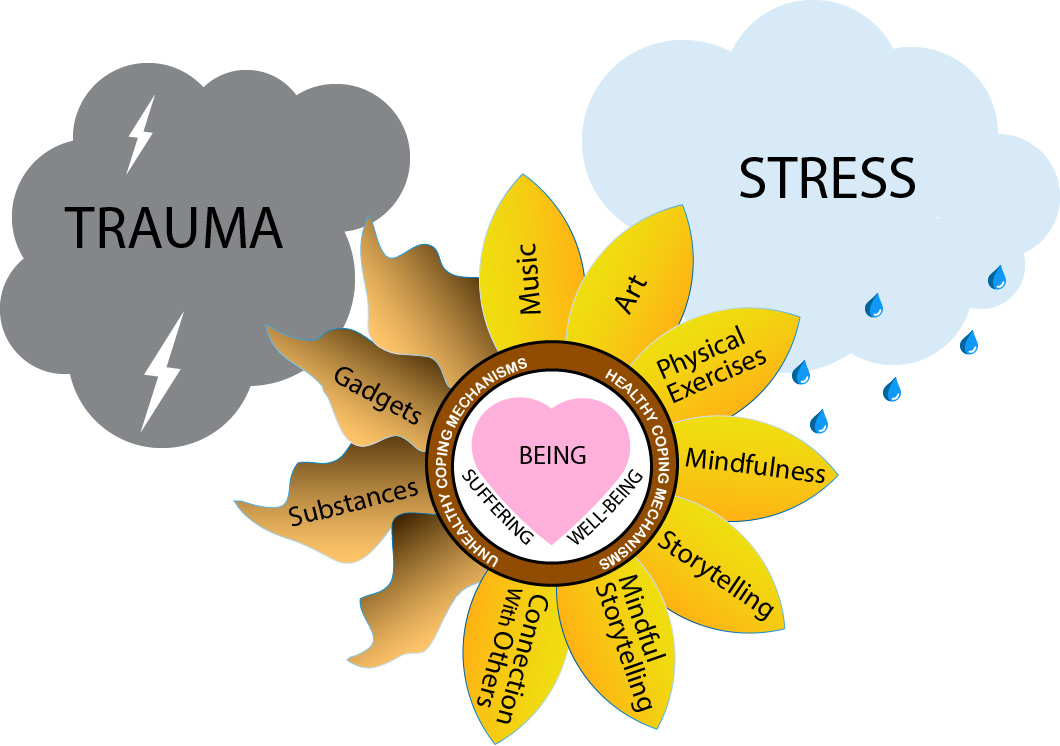From Being to Well-being: Conceptual Framework
Life, or the state of being, is constantly influenced by various events. The same stressful or traumatic event does not affect different people in the same way (American Psychiatric Association 2022; McGonigal, 2015; and van der Kolk, 2015).
Conceptual Framework.

Note. The heart in the center symbolizes a person’s life, or being, that may be experienced as states of suffering or well-being. The balance of stress, trauma, and coping mechanisms determines what state is experienced. The petals on the flower represent various coping mechanisms. The yellow petals indicate healthy coping mechanisms, while the brown ones represent unhealthy ones. Some brown petals have been left empty on purpose to show that certain healthy coping mechanisms can become unhealthy, depending on how they are used by individuals. Raindrops symbolize events that can frequently trigger stress. Lightning in a dark cloud symbolizes traumatic events.
Stress can transform into trauma if healthy coping mechanisms are not developed to manage it (Kanojia, 2023; Linsin, 2016; Mate & Mate, 2022; and van der Kolk, 2015). Lightning symbolizes traumatic events. According to the American Psychiatric Association (2022), traumatic events may or may not be developed into “Post Traumatic Stress Disorder (PTSD)” (APA, 2022, p. 301), depending on the individual’s reaction to those events. According to Boulder Crest Foundation (2024), after trauma, a person can experience a positive psychological transformation “Posttraumatic Growth” (para. 1). So, traumatic events may affect a person positively or negatively.
Each petal of the flower symbolizes coping mechanisms that can be used during stressful and traumatic times. Vivid, yellow, petals symbolize healthy coping mechanisms that transform stressful and even traumatic events into well-being or at least into being (Kanojia, 2023; Kariv & Heiman, 2005; and van der Kolk). Faded petals symbolize unhealthy coping mechanisms that often exacerbate stressful or traumatic events and transform being into suffering (Kanojia, 2023; Kariv & Heiman, 2005; and van der Kolk). Some people dwell in a bud-state: unable to understand, find, or use coping mechanisms that work for them (Kariv & Heiman, 2005). Metaphorically speaking, the more “healthy” petals you have in your pocket, the better you feel.
In the end, two opposing forces influence human well-being: one is the stress triggered by events, and the other is our internal reactions and physical actions in response to stress. The coping mechanisms are the choices people make to deal with stress when facing stressful situations (Dalai Lama, 2002; Leon, 2023; McGonigal, 2015; and Seligman, 2013).
References
American Psychiatric Association. (2022). Diagnostic and statistical manual of mental disorders: DSM – 5 – TR™. (5th ed). Text Revision. American Psychiatric Association.
Boulder Crest Foundation. (2024). Understanding Posttraumatic Growth.
https://bouldercrest.org/research-resources/what-is-posttraumatic-growth-ptg/
Dalai Lama (2002). How to practice: The way to a meaningful life. J. Hopkins, Trans.).
Atria Books.
Kanojia, Al. [HealthyGamerGG]. (2023, May 13). Here’s why trauma is so common (A
deep dive into understanding trauma) [Video]. YouTube.
https://youtu.be/8TkbP4XfggM?si=-J2saEt90-fcYT-g
Kariv, D., & Heiman, T. (2005). Task-Oriented Versus Emotion-Oriented Coping Strategies: The
Case of College Students. College Student Journal, 39(1), 72–84.
Leon, C. E. (2023). Vicarious trauma: a phenomenological qualitative study of school
counselors and self-care. Doctoral Dissertations and Projects. 4417.
https://digitalcommons.liberty.edu/doctoral/4417
Linsin, M. (2016). The happy teacher habits. JME.
Mate, G. & Mate, D. (2022). The myth of normal: trauma, illness & healing in a toxic culture.
Avery.
McGonigal, K. (2015). The upside of stress: why stress is good for you, and how to get
good at it. Avery.
Seligman, M. E. P. (2013). Using the new positive psychology to realize your potential for
lasting fulfillment. Authentic happiness. Atria.
Van der Kolk, B. (2015). The body keeps the score: Brain, mind, and body in the healing of
trauma. Penguin Books.

